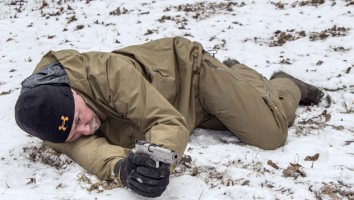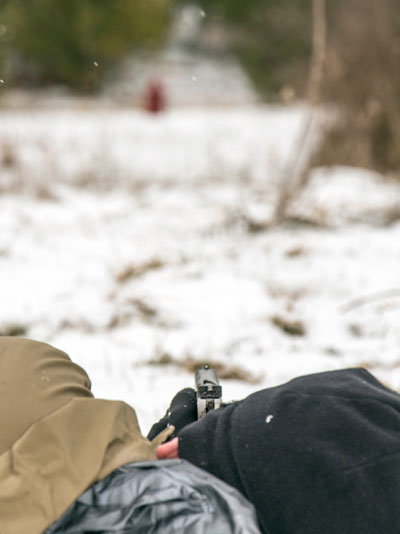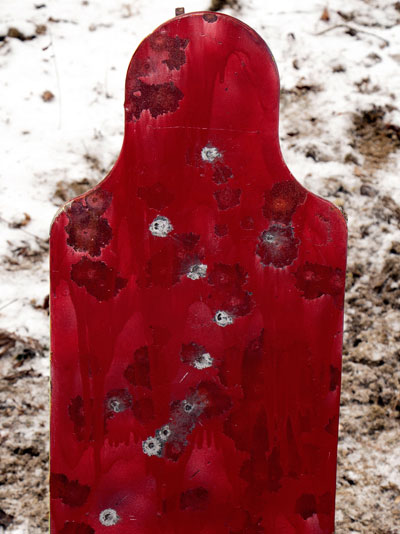
There's a difference between trick shooting and long-range shooting. There's also a difference between hitting something and hitting it hard enough to matter. Handguns are generally considered short-range firearms, because it's difficult to achieve hits with them at extended distances. In addition, they don't hit very hard at long range. So, at what range is the divide between trick shooting and serious shooting with a handgun?
It could be argued once the range extends to where first-round hits with a handgun become rare, serious shooting stops and trick shooting begins. For men like Jerry Miculek and the late, great Bob Munden, that distance is much farther than it is for you and me. Still, you might be surprised at how far away you can get hits with a defensive handgun.
First things first: Getting a hit at long range with a defensive handgun might not be the main priority. Former military sniper and firearm instructor Cody Carroll told me about training operatives on the U.S./Mexico border, where he was not allowed to have a rifle. So, in advance of his deployment, he practiced with his Glock out to 600 yards. No, he could not hit every time, but sometimes in a defensive situation effective suppressing fire is better than nothing.
Will a handgun bullet bounce off someone at 300 yards? Nope. At 300 yards, a bullet from most 9 mm +P loads will still be moving at about 800 to 850 fps. At that velocity the bullet might not expand, but it will have enough energy to punch through a tissue and reach vital organs. How about at 600 yards? Here, the bullet will have slowed to about 670 fps. It won't expand, but it will let the air out of a bad guy if it hits center mass. Getting hit with a handgun bullet at long range is not a laughing matter.
The real question is, how do you do it? After all, we are not Elmer Keith and can't whack a running deer at 600 yards with a 6-inch revolver. I've been working with defensive handguns at long range, mostly out of curiosity, for the last several months. Here's what I've learned.
Do the Math
Just like portions of a reticle in a riflescope, the front sight of a handgun subtends to a certain measurement at a given distance. You can calculate the subtension (X) using the formula X=(SR)/D, where S is the height of the front sight, R is the range to the target, and D is the distance from your eye to the front sight (all of the measurements, including range, should be in inches). Once you know the subtension of the front sight at a given distance, you can compare this measurement to bullet drop at the same range and use it to account for holdover. Thing is, this method only gets you close, because the way your eye sees the front sight can alter the mathematical solution. Still, it gives you a good place to start.
Hit the Dirt
You need a solid position to make long-range hits, and handgun prone is about as solid as it gets. Lie on your strong side, almost perpendicular to your line of sight to the target. Rest your hands on the ground and your head on your strong-side arm. Remember, as your position changes, so too might the distance from your eye to the front sight, which changes the sight's subtension. If you're serious about long-range handgunning, have someone measure the distance between the front sight and your dominant eye, and try to keep it consistent.
100 Yards
At this distance, hold right on the target's head using a conventional sight picture. Most defensive handgun cartridges will drop between 8 and 16 inches at 100 yards. A head hold should put your bullet somewhere in the torso. You can expect more than half of the defensive loads available to show some expansion at 100 yards, and most decent shooters should be able to hit a silhouette target at 100 yards about half the time.
200 Yards
Bullet drop at this distance can extend into the 6-foot range. Now you have to start using more of your front sight. The key is to alter your sight picture, not your hold. In other words, raise the front sight above the rear notch, and keep the front sight on the target. Don't use the common sight picture and hold high; you won't be able to see the target.
Assuming a distance of 32 inches from your eye to the front sight, a front sight that is .32 inch tall will subtend to about 72 inches at 200 yards. However, our eyes are not the same and sights look different in different light, so you'll have to experiment to see how much front sight to hold high.
If you're using a bladed front sight, you can make a mark on the blade that shows how much you need to hold above the rear notch. Then, just line up the mark with the top of the rear notch and aim with the top of the post. For example, with a 0.32-inch front sight and a 200-yard drop of 46 inches, you'll need to hold a little more than half the sight above the top of the rear notch. Once you learn how much sight to use, you should hit a silhouette target at 200 yards about 25 percent of the time.
300 Yards
Here you're moving into the trick-shooting arena. Even the flat-shooting .327 Fed. Mag. will drop almost 12 feet, and a .45 ACP bullet will drop about 17 feet. Of course, you might get lucky with your sight. That .32-inch front sight now subtends to 9 feet, but if you had a sight that was .42 inch tall, the post would equal the 12-foot drop of the .327 Fed. Mag. bullet at 300 yards. In that case, you would hold all the front sight above the top of the rear notch.
With a shorter front sight, you'll have to hold all the sight, and some of the barrel and slide, above the notch. Again, it will take some experimentation to figure out how much. Hit rate on a silhouette at 300 yards will most likely drop under 25 percent. However, you should still be able to hit a barn door or lay down some serious suppressing fire.
Shooting at extreme distances with a pistol is not an exact science, and compensating for the effect of wind on a handgun bullet is a whole other story. But with practice, you can make a bad guy shooting at you with an AK from 300 yards find a hole to crawl in pretty darn quick. If you hit him, call 911; he's going to need an ambulance.
How Much Hold?
 In order to hit with a handgun at long range, you need to have a good idea of how much bullet drop to compensate for—just like with a rifle. Corrections are much more difficult to make with fixed, iron sights than on a riflescope, but finding a hold that will result in a hit is not impossible. In theory, it's simple math, but a hold variation of just a couple tenths of an inch can mean the difference between a hit and a miss.
In order to hit with a handgun at long range, you need to have a good idea of how much bullet drop to compensate for—just like with a rifle. Corrections are much more difficult to make with fixed, iron sights than on a riflescope, but finding a hold that will result in a hit is not impossible. In theory, it's simple math, but a hold variation of just a couple tenths of an inch can mean the difference between a hit and a miss.
The table below shows impact velocity, bullet drop and necessary sight correction at 100, 200 and 300 yards. The sight correction subtends to the bullet drop at the listed range. For example, when shooting at a 200-yard target with the .40 S&W 155-grain Winchester Silvertip load, you need to place the front sight on the target and hold .28 inch of it above the top of the notch in the rear sight.
Calculations are based on a 32-inch distance from the eye to the front sight. If that measurement differs for you, apply the X=(SR)/D formula to determine how much of the front sight to place above the rear notch. It will take a bit of experimentation to find the correct hold.
| 100 Yards | |||
| Load | ImpactVelocity | BulletDrop | SightCorrection |
| .327 Fed. Mag., Speer 100-grain Gold Dot | 1,116 | -9 | .08 |
| 9 mm Luger +P, Remington 124-grain Golden Saber | 1,010 | -12 | .10 |
| .38 Spl., Federal Premium 110-grain Hydra-Shok | 850 | -17 | .15 |
| .357 Mag., Buffalo Bore 140-grain Barnes TAC-XP | 1,150 | -8 | .07 |
| .40 S&W, Winchester 155-grain Silvertip | 1,010 | -12 | .10 |
| .45 ACP +P, DoubleTap 160-grain Barnes TAC-XP | 902 | -15 | .13 |
| 200 Yards | |||
| Load | ImpactVelocity | BulletDrop | SightCorrection |
| .327 Fed. Mag., Speer 100-grain Gold Dot | 965 | -50 | .22 |
| 9 mm Luger +P, Remington 124-grain Golden Saber | 915 | -63 | .28 |
| .38 Spl., Federal Premium 110-grain Hydra-Shok | 755 | -92 | .40 |
| .357 Mag., Buffalo Bore 140-grain Barnes TAC-XP | 970 | -46 | .20 |
| .40 S&W, Winchester 155-grain Silvertip | 900 | -63 | .28 |
| .45 ACP +P, DoubleTap 160-grain Barnes TAC-XP | 805 | -80 | .35 |
| 300 Yards | |||
| Load | ImpactVelocity | BulletDrop | SightCorrection |
| .327 Fed. Mag., Speer 100-grain Gold Dot | 870 | -135 | .40 |
| 9 mm Luger +P, Remington 124-grain Golden Saber | 840 | -164 | .48 |
| .38 Spl., Federal Premium 110-grain Hydra-Shok | 675 | -239 | .71 |
| .357 Mag., Buffalo Bore 140-grain Barnes TAC-XP | 865 | -128 | .38 |
| .40 S&W, Winchester 155-grain Silvertip | 820 | -166 | .49 |
| .45 ACP +P, DoubleTap 160-grain Barnes TAC-XP | 725 | -210 | .62 |
| Impact velocity measured in fps. Bullet drop and sight correction measured in inches. | |||





































